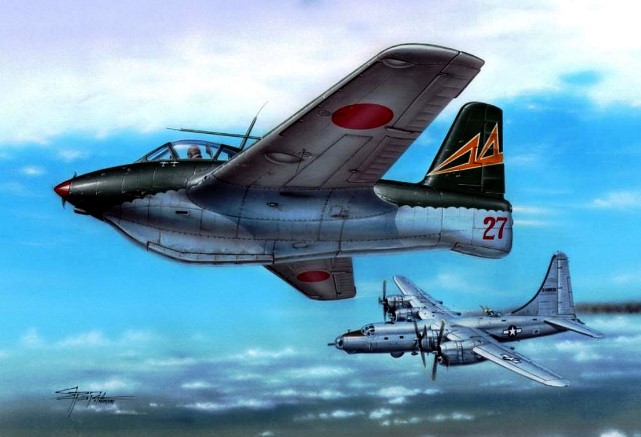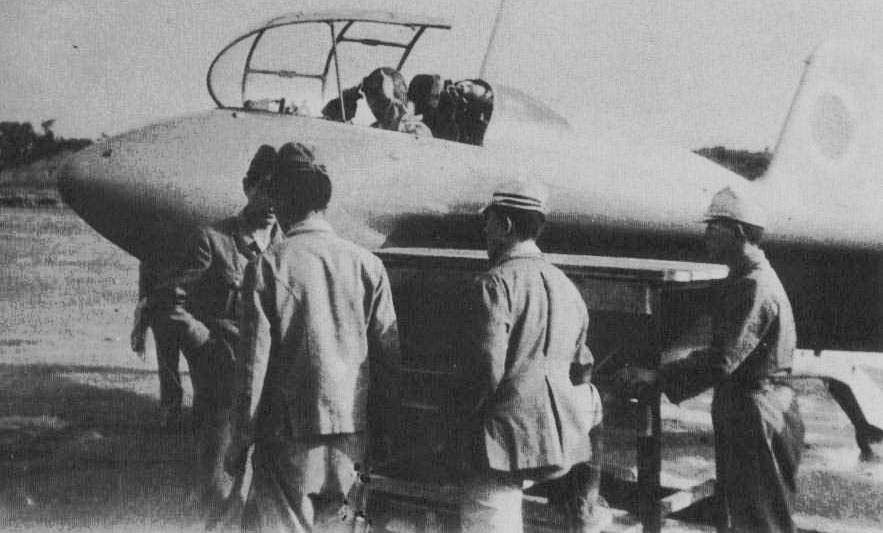Mitsubishi J8M rocket-powered interceptor

Imperial Japanese Navy J8M Shusui ("Sword Stroke") - 1943-1945
© 2018 Bob Hackett
Fall 1943:
Bad Zwischenahn airfield, Germany. Japanese military attachés are given a demonstration of the Messerschmitt Me-163 Komet by the Erprobungskommando 16, the Luftwaffe evaluation squadron charged with service testing the revolutionary rocket-propelled interceptor. The attachés send enthusiastic reports back to Tokyo about the potential of the Me-163 to defend Japan's homeland against the USAAF strategic bombing offensive predicted to start in 1944.
Since Japan would first have to master production of large quantities of hydrogen peroxide and hydrazine for rocket fuel, many contractors and Japanese officers have concerns about putting the Me-163 into service. Others question whether the Komet's short 7.5 minute powered endurance is a liability since it will have to reach higher altitudes to attack Boeing B-29 "Superfortresses" than over Europe where the Komet's main prey are unpressurized B-17 "Flying Fortresses" and Consolidated B-24 "Liberator" heavy bombers. Nevertheless, despite these and other concerns, negotiations proceed for licensed production in Japan of the Me-163.
As the production negotiations continue, it is decided that a Japanese mission will be sent to Germany with Army and Navy representatives to observe manufacture of the Me-163 and to learn its operational procedures. It is also decided that not one, but two IJN submarines, will be used to bring the cargo to Japan in case one submarine is lost on the return voyage. [1]
16 December 1943:
At 1100 (JST), Cdr (Rear Admiral, posthumously) Kinashi Takakazu's Type B1 submarine I-29 (coded Matsu (Pine) by the Japanese) departs Seletar Naval Base, Singapore for Nazi-occupied France.
15 February 1944:
Kiel, Germany. U-1224, a Type IXC/40 German U-boat, is handed over to the IJN. The Japanese rename her Satsuki (Month of First Buds) No. 2." LtCdr (Cdr, posthumously) Norita Sadatoshi is the CO. Later that month, she is commissioned in the IJN as RO-501.
1 March 1944:
Me-163 license production negotiations are completed. The Japanese negotiate the rights to licence-produce the aircraft and its Walter HWK 509A rocket engine. The engine license alone costs Japan 20 million Reichsmarks. The Germans agree to supply Japan with complete blueprints and manufacturing data for the new Me-163B variant, as well as one complete airframe, two sets of sub-assemblies and three complete rocket motors.
11 March-15 April 1944:
I-29 arrives safely at Lorient, France. During her stay, I-29 embarks 18 passengers (including four Germans) and takes on an HWK 509A-1 bi-fuel rocket motor used on the Me-163 Komet interceptor and a Jumo 004B engine used on the Me-262 jet fighter.
30 March 1944:
Kiel, Germany. At 0800, RO-501 departs, carrying a full set of Messerschmitt Me-163 rocket interceptor blueprints. [1]
16 April 1944:
I-29 departs Lorient, escorted by seven M-class minesweepers. Technical Cdr Iwaya Eiichi carries blueprints of Messerschmitt Me-163 rocket interceptor and Me-262 jet fighter. [1]
13 May 1944:
Atlantic Narrows, 500 miles W of Cape Verde Islands. Lt John E. Johansen's FRANCIS M. ROBINSON (DE-220) is on an ASW patrol. At 1900 hours, ROBINSON's sonar operator detects a target he classifies as a submarine. ROBINSON fires a barrage of 24 ahead-thrown Mark 10 "Hedgehog" projector charges, followed by five salvos of Mark 8 magnetic influence depth charges. Four underwater explosions are heard and recorded. RO-501 (ex-U-1224) sinks at 18-07N, 33-12W.
July 1944:
The JNAF issues a 19-shi specification for the design of the rocket-powered defense fighter. The specification is sent to Mitsubishi Jukogyo K.K., which is to produce both the JNAF version - the J8M1 Shusui - and the JAAF version Ki-200, but Mitsubishi refuses to proceed because of so much discord within the Japanese military command on the practicality of the aircraft.
14 July 1944:
At 1030, I-29 arrives safely at Singapore. I-29's passengers, including Iwaya disembark with their plans and documents and proceed by air to Japan, but most of the German scientific cargo remains aboard. The Japanese decide to attempt to copy the Me-163 using a basic instructional manual on the Komet in the hands of Cdr Iwaya.
22 July 1944:
At 0800, I-29 departs Singapore for Kure.
26 July 1944:
Luzon Strait. W entrance of Balintang Channel. About 1700, Cdr Alan B. Banister's SAWFISH (SS-276) sights I-29 running on the surface. Hs fires four torpedoes and gets three hits that sink I-29 almost immediately at 20-10N, 121-55E. Cdr Kinashi, Japan's leading submarine "Ace", is among the 105 crewmen and passengers that are lost. He is honored by a rare two-rank promotion to Rear Admiral, posthumously.
The loss of the German aircraft aboard I-29 slows the Japanese jet program greatly, but their blueprints, flown to Tokyo, arrive safely. They are used immediately to develop the Mitsubishi J8MI Shusui ("Sword Stroke") based on Me-163 and the Nakajima Kikka ("Orange Blossom") based on the Me-262.
27 July 1944:
A joint Army-Navy commission formally orders the J8M Shusui aircraft from Mitsubishi. The Army designation is Ki-200. From this point, the program takes on a more serious effort and urgency.
8 September 1944:
The cockpit mockup is reviewed.
26 September 1944:
The full scale mockup of the Shusui is reviewed. A joint Army-Navy production schedule is drawn up with 155 aircraft to be delivered by March 1945. By September 1945, 1,300 aircraft are to be delivered and no fewer than 3,600 delivered by March 1946.
Because of the loss of submarine RO-501 (ex-U-1224) and that the joint-service commission never made it Germany to observe production, the Mitsubishi team has to make some educated guesses during the design process in preparing the Shusui for production. In addition, some of the basic equipment like batteries and radios are sized and weighed differently in Japan compared to German equipment, and this in turn affects not just airframe structure, but also weight and balance of the aircraft.
Mitsubishi is also responsible for getting the rocket motor, designated Toku Ro. 2, into production, but on the day of the first bench test of the motor, B-29 heavy bombers attack the plant. Numerous technical problems mount in the motor development as the Japanese have to substitute some materials for others in the design which would later turn out to be unsuitable for a production motor.
By April 1945, the Shusui aircraft are ready, but the rocket motor program is 3 months behind schedule. It is decided if the Toku Ro. 2 could run for just two minutes, they'd attempt the Shusui's first powered flight on 22 April, but the engine explodes during a ground test.
B-29 attacks exert their toll on the program. The engineering groups periodically have to move to new facilities. Eventually two groups are set up, each tasked with getting the Toko Ro. 2 running.
June 1945:
One group has their motor running four minutes on the bench and the other group has their motor bench tested to three minutes. It is decided that these bench tested motors will be used for the Shusui's first flight, but ground runs continue to reveal problems with the motor.
5 July 1945:
The J8M1 Shusui aircraft is declared ready for its first maiden powered flight.
 Ground crewmen ready prototype Shusui for flight test.
7 July 1945:
Ground crewmen ready prototype Shusui for flight test.
7 July 1945:
Toyohiko Inuzuka starts up the motor for the first Shusui powered flight. After an 11-second takeoff run, the J8M1 Shusui becomes airborne and jettisons its takeoff dolly as planned. At 1,150 feet, Inuzuka begins to have engine problems as the motor begins to sputter and then quits. He is able to reach 1,640 feet, where he levels off and turns for the glide back to Yokuku Airfield. Releasing his remaining fuel via emergency release valves, he realizes he has made too many S-turns and is going to come up short of the airfield. Aware he is about to hit a house on the airfield perimeter, Inuzuka deliberately stalls the Shusui by abruptly pulling the nose up. The aircraft cartwheels and misses the house, but is destroyed. A few days later, Inuzuka dies from his injuries.
Analysis shows that he suffered fuel starvation during his climb- the acceleration and his angle of climb caused the fuel to slosh back and recede from the tank outlet. A few days later, two other motors that are being bench tested for the flight test program explode. This leaves only one complete rocket motor that has been tested and it was in the possession of the Army for installation in their Shusui prototype.
August 1945:
Full-scale production readiness is almost at hand and component construction is already underway. Flight testing is to resume, despite another explosion of the fuel mixture during a ground test days after the crash. The J8M design is finalized.
6 August 1945:
As the Army and Navy struggle to get their program back on track, Hiroshima is atomic bombed.
9 August 1945:
Nagasaki is also atomic bombed.
15 August 1945:
The Emperor and Japan unconditionally surrender. All work on the J8M ceases. Seven J8M1/Ki-200 were built by Mitsubishi.
Authors’ Notes:
Germany tries to send another Komet to Japan in U-864, but in February 1945 the submarine is sunk near Bergen, Norway by British submarine HMS VENTURER.
[1] One of three sets set of Me-163 blueprints; the others are carried aboard I-29 and U-511.
[2] Events in Europe keep the joint-service mission from arriving there.
-Bob Hackett
Back to the IJNAF Page






